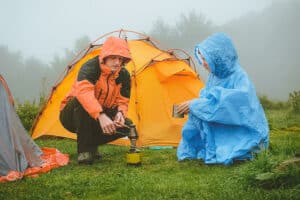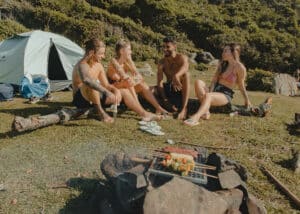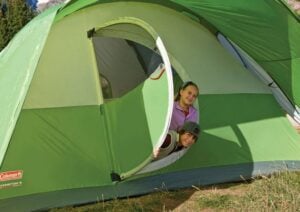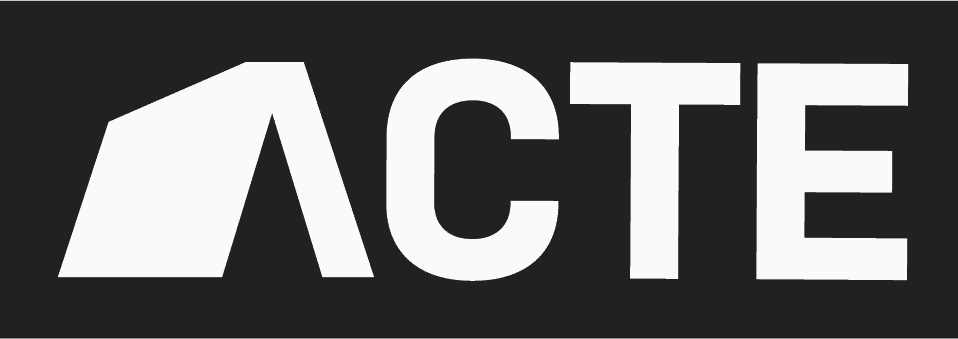The smell of wood smoke, roasting marshmallows, and sitting around a blazing fire with friends sparks something deep inside that can’t be replicated.
But if you’ve ever tried to build a campfire when camping outdoors or even at home and couldn’t get it, right-no worries! This blog will teach you how to build a camp fire as the pros do.
This post contains detailed instructions on everything from where to find dry kindling, what type of firewood best suits different conditions, and how much time each task should take so that building a campfire becomes as easy as pie.
How do you make a campfire step by step?
Below are the basic steps you need to follow when making a campfire.
- Choose the right spot
- Collect your materials
- Start with the tinder
- Add kindling
- Light the tinder
- Add logs and watch it grow
People who like to camp should read this so they can know how to build a campfire. This is important because not knowing how to make a campfire when you’re setting up your campsite out in the middle of nowhere and can’t pull up the internet, can be really frustrating.
4 Different Types of Campfires
There are many different types of campfires that can be built, but the four most common types are the Teepee fire, the Log Cabin fire, the Star fire, and the Dakota fire hole.

The Teepee Fire
The teepee fire is the simplest type of campfire to build and it is also the most popular. To build a teepee, start by stacking small sticks into a cone-shaped pile. Once the pile is big enough, add larger sticks on top of the small ones and then light the fire at the base.
✅ Pros:
- Sticks act as a barrier that blocks wind, it’s more efficient to start and maintain
- Larger pieces of wood can be added with little hassle to keep the fire going
❌ Cons:
- Can be frustrating for beginners
- Not as stable as some of the other types of fires and it can easily topple over
- Can be difficult to get the fire started with just small pieces of wood

The Star fire
The star fire is a bit more complicated to build, but it burns very evenly and produces a lot of heat. To build a star, start by creating a small tepee fire in the middle of your camp fire ring. Then, using long sticks, create a star-shaped pattern around the teepee. Finally, add smaller sticks to the outside of the star and light the fire.
✅ Pros:
- The star fire is very easy to maintain
- Burns evenly
- Produces a lot of heat
❌ Cons:
- It can be difficult to get the fire started.
- More complicated to build than other types of fires.

The Log Cabin Fire
The log cabin fire is the most difficult type of campfire to build, but it is also the most reliable. To build a log cabin, start by stacking logs into a square-shaped pile. Make sure that the logs are all the same size and that there is plenty of space between them. Then, light the fire at the base of the pile and let it burn.
✅ Pros:
- It is the most reliable type of fire
- Burns evenly produces a lot of heat
- Stable and sturdy because logs keep each other in place
❌ Cons:
- Logs tend to burn quickly and unevenly, so it can be difficult to get a good fire going.
- Produces a lot of smoke, which can be unpleasant
- It can be difficult to find the right type of wood

The Dakota Fire Hole
If you are in a hurry or don’t have enough materials to build a traditional campfire, you can use the Dakota fire hole. To make a Dakota fire hole, start by digging a hole in the ground that is about 1 foot wide and 1 foot deep. Then, place some small sticks in the hole and light them on fire. Finally, cover the hole with dirt to extinguish the fire.
✅ Pros:
- Quick and easy way to build a fire.
- Great way to start a fire with limited materials.
- Perfect for starting a fire in windy conditions.
❌ Cons:
- It can be difficult to get the fire going.
- The fire can easily die out if not tended to properly.
- If the hole is not deep enough, the fire will not generate enough heat to stay lit.
Which type of campfire is best for you will depend on your needs and preferences.
The materials you’ll need to make a campfire
When starting a campfire, the materials you’ll need are few and simple: a small fire ring or designated fire pit, some tinder, kindling, and firewood/logs.
Small fire pit
A small fire pit key in building a campfire. The ideal size for a small campfire ring or fire pit is about 18-24 inches (45-65 cm) in diameter. You can use a circular or square shape, depending on what you have available.
Tinder
Tinder is the material that will ignite and start the fire. It is typically made of fine, dry, fibrous material and is easily combustible. Some good examples of tinder include:
- Dryer lint
- Newspaper
- Cotton balls or Q-tips dipped in Vaseline
- Charred wood
Kindling
Kindling is the material that will be used to feed the fire as it grows. It is slightly larger in size than tinder and is used to ignite larger pieces of wood. Some good examples of kindling include:
- Small branches
- Small Twigs
- Wood shavings
- Pine cones
- Birch bark
Firewood/logs
Firewood is the final piece of the campfire puzzle. It is the largest and most important piece and will be what the fire burns. It is best to use dry, seasoned wood for your campfire. If you don’t have any dry wood available, you can try to find a downed tree or limb to use.
Now that you have all of the materials, it’s time to start building your campfire!
6 Steps to help you make a campfire like a pro
Building a campfire is a rite of passage for any camping enthusiast. It can be the difference between an enjoyable camping trip and a miserable one. If you’re looking to make a campfire like a pro, follow these six easy steps:
1. Choose the right spot:
Make sure you choose a spot that’s away from trees, bushes, and other flammable objects. The spot should also be relatively flat so the fire will be easy to build.
2. Collect your materials:
You’ll need tinder, kindling, and logs to build your campfire. Tinder is a material that easily can catch fire, such as paper or dried grass. Kindling is a material that’s a little bit bigger than tinder, such as twigs or small branches. Logs are the largest pieces of wood you’ll use to build your fire.
3. Start with the tinder:
Place some tinder in the middle of your spot. The tinder should be in a pile that’s about the size of a grapefruit. If you don’t have tinder, you could use dryer lint.
4. Add kindling:
After you’ve placed the tinder in the middle of your spot, add some kindling on top of it. The kindling should be in a pile that’s about the size of a baseball.
5. Light the tinder:
Use a lighter or matches to help the tinder catch fire. Once the tinder is on fire, blow gently on it to help it spread.
6. Add logs:
Once the tinder is burning, add larger pieces of wood to the fire. Keep adding logs until the fire is big enough for your needs.
Now you know how to make a campfire like a pro! Follow these steps and you’ll be able to enjoy a roaring fire while camping.
6 tips for building a campfire in different scenarios
There’s no one-size-fits-all answer for how to construct a campfire. The best way to build a fire will depend on the situation and the materials you have available. However, there are some general tips that can help in most situations:
1. How to build a camp fire with wet wood
If you’re trying to build a fire and you have wet wood available, the best way to do it is by using a Dakota fire hole. The Dakota fire hole is a method where you dig a small hole in the ground and put the wood in it. You then light the tinder on top of the hole and cover it with dirt. The dirt will help to keep the fire going and the wood will eventually dry out and ignite.

2. How to build a campfire on the beach
Building a campfire on the beach is different than building one in the woods. There are a few things to consider when building a fire on the beach:
- The wind: The wind can be a challenge when building a fire on the beach. Make sure your tinder and kindling are well-protected from the wind, or you may have trouble getting it to light.
- The sand: If you’re building your fire on the sand, make sure the sand is dampened first. Dry sand will not burn well.
- The tide: Be careful that your fire does not get too close to the tide, or you may lose your fire altogether.
- The ocean: Never build a fire too close to the ocean, as the waves can extinguish the flames.
3. How to build a campfire in your backyard
When building a campfire in your backyard, there are a few things you need to keep in mind. For one, you don’t have to worry about finding a spot that’s far away from trees and other flammable objects. You also don’t have to worry about the wind or the sand. However, you do need to make sure you have enough room for the fire, and you need to be careful not to let the fire get out of control.
4. How to build a campfire in the rain
You’ll want to take into account the fact that the wood will be wet. This means that you’ll have to use a different method than normal for getting the fire going. One option is to use a Dakota fire hole (described above). Another option is to use lighter fluid or charcoal fire starters to help the wood catch fire quicker. Just make sure you’re careful when using these products, as they can be dangerous if not used correctly.
5. How to build a campfire in the snow
When building a campfire in the snow, the snow will act as an insulation layer and will help to keep the fire going. However, the snow can also put out the fire if it gets too wet. Make sure you have a way to protect your fire from getting wet, such as building it under a shelter or using a tarp. You’ll also need to use larger pieces of wood when building a fire in the snow, as the wood will not ignite as easily as it would in the forest.
6. How to build a campfire with sticks
Building a campfire with sticks is different than building one in the forest because you have to use larger pieces of wood. The sticks will not ignite as easily as the wood in the forest, so you’ll need to use bigger pieces to get the fire going. You also need to be careful not to let the fire get out of control, as it can easily spread in a backyard setting.
How to safely build a campfire
When building a campfire, it’s important to keep fire safety in mind. Here are a few tips for safely building a campfire:
- Never build a fire too close to the house or other flammable objects.
- Make sure you have plenty of room for the fire and be careful not to let it get out of control.
- Make sure the wind isn’t blowing the flames in the wrong direction.
- Be careful when using lighter fluid or charcoal fire starter.
- Be sure to put out the fire completely before leaving the fire unattended.
The above are just a few tips for safely building a campfire. For more information, please consult an expert.
How to safely put out a campfire
So you’ve built a roaring campfire, but what do you do when it’s time to go to bed? Or maybe you need to put out the fire before leaving camp. Here are a few tips on how to safely and efficiently put out a campfire:
- Allow the fire to die down naturally. Resist the urge to pour water on a hot fire, as this will only create more problems. The embers will continue to burn and could start a forest fire.
- If you must put out the fire quickly, spread the ashes around with a shovel and then pour water over them. Be sure to wet all of the ashes, not just the top layer.
- Never leave a campfire unattended. Even if you’ve put it out, embers can still smolder and start a fire.
Remember to always practice safety when building and putting out a campfire. With these tips, you’ll be able to enjoy your campsite safely and worry-free. Happy camping!
Frequently asked questions
How do I know if the wood is wet?
The easiest way to tell if the wood is wet is to try and light it. If the wood doesn’t ignite, then it’s likely wet.
What should I do if my fire gets out of control?
If your fire gets out of control, you should immediately call 911. Do not try to put out the fire yourself.
How do you keep a firepit going?
To keep a firepit going, you’ll need to add more wood to the pit every hour or so. Make sure you don’t add too much wood at once, as this could cause the fire to get out of control.
What type of wood should I use for a campfire?
The best type of wood to use for a campfire is dead, dry wood. You can find this wood in the forest or at your local hardware store. If you’re using wet wood, make sure you use a different method to get the fire going (such as using lighter fluid or charcoal fire starters).
Is it safe to build a campfire in my backyard?
Yes, it is safe to build a campfire in your backyard as long as you follow the safety guidelines mentioned in this article. Just be sure to build the fire in a safe place and keep an eye on it so it doesn’t get out of control.
What can I use to start a fire with sticks?
You can use a number of items to start a fire with sticks, including lighter fluid, charcoal fire starters, or a battery-powered ignition system.
What type of campfire burns the longest?
The campfire that will burn the longest is the Dakota fire hole. This type of campfire burns very slowly and doesn’t produce a lot of sparks or flames.
How big should a campfire be?
A campfire should be at least 3 feet wide and 2 feet high. If you’re using a Dakota fire hole, the fire should be about 12 inches wide.
How do I put out a campfire?
To put out a campfire, you need to drown it with water. You can use a bucket, shovel, or hose to do this. Be sure to pour enough water on the fire to completely extinguish it.
How do you make a big campfire?
To make a big campfire, you’ll need to use larger pieces of wood and build the fire in a circle. The fire should be about 3 feet wide and 2 feet high. Be careful not to let the fire get out of control.
What should I do if I’m building a campfire in the snow?
If you’re building a campfire in the snow, you’ll need to use bigger pieces of wood and take extra precautions to keep the fire from getting wet. You should also make sure the wind isn’t blowing the flames in the wrong direction.
What should I do if I’m building a campfire in the rain?
When building a campfire in the rain, you’ll need to use a different method than normal for getting the fire going. One option is to use a Dakota fire hole (described above). Another option is to use lighter fluid or charcoal starter. Just make sure you’re careful when using these products, as they can be dangerous if not used correctly.
What could happen if I leave a fire unattended?
Leaving a campfire unattended can be dangerous, as it can easily get out of control. If the fire gets out of control, you should immediately call 911. Do not try to put out the fire yourself.
Recap and Further Reading
Campfires are a great way to have fun and get closer with friends and family. Building campfires may seem challenging, but by following the instructions in this blog post you should be able to build one that will last all night long.
From how to do it on the beach or at your home, these tips can help no matter where you want to build your fire! Keep fire safety in mind when building a fire as well because it is important not to let them get out of control. If you follow our advice here, then there’s nothing stopping you from being an expert camper!





